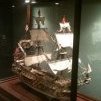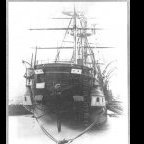MORE HANDBOOKS ARE ON THEIR WAY! We will let you know when they get here.
×

Roger Pellett
-
Posts
4,519 -
Joined
-
Last visited
Reputation Activity
-
 Roger Pellett got a reaction from scrubbyj427 in Armstrong Frederick Cannon by allanyed - 1:24 scale
Roger Pellett got a reaction from scrubbyj427 in Armstrong Frederick Cannon by allanyed - 1:24 scale
Allan,
Nice work! For those without access to a lathe, a piece of brass tubing with teeth filed into the business end will also work for your trunnions cutting tool. To keep the drill press jaws from crushing it you can reinforce it with the next smaller telescoping size.
Roger
-
 Roger Pellett got a reaction from ERS Rich in USS Enterprise (CV-6) by ted99 - Trumpeter - 1:200 - PLASTIC
Roger Pellett got a reaction from ERS Rich in USS Enterprise (CV-6) by ted99 - Trumpeter - 1:200 - PLASTIC
Have you read Shattered Sword? If not it might be an interesting book to take on your trip. It would be of interest as the authors describe in considerable detail how American and Japanese operated and how these operational details affected the outcome at Midway. You might find some gems that help you to better understand constructional details not explained by the instructions.
Roger
-
 Roger Pellett got a reaction from mtaylor in Small ship anchor handling
Roger Pellett got a reaction from mtaylor in Small ship anchor handling
It may just be the angle of the photo but those anchors appear to be over scale. If the revenue cutters were actually fitted out with the metal stock anchors it would that they would have been brought inboard, the stocks collapsed, and the anchors stored flat on d.eck lashed to ringbolta.
Roger
-
 Roger Pellett reacted to Javelin in Chaconia by Javelin - 1/100 - RADIO - LPG Tanker
Roger Pellett reacted to Javelin in Chaconia by Javelin - 1/100 - RADIO - LPG Tanker
Well a very old project of mine started back in 2010. It's been around ever since, working on it on and off until now. It's been bothering me ever since, she's the reason why I don't like to have a shelf of doom with long lasting projects. With every new small scale project I start, she's standing behind me, nagging for attention.
As of late I've been busy planning to finally finish her and since the Spartacus project is on hold for the time being, I've slowly restarted construction on Chaconia.
At first I built in a continuous period, however the pace slowed down during the detailing phase and eventually I've abandoned it. At first it would be temporary, just to take on a smaller project and finally get something finished, but as you can imagine, then came another "quick" project and another... Sometimes I did put her in the water and did some small jobs, but it never became my main project again. Now I'm intending to promote her again to the main project.
So what is she?
Chaconia is an LPG tanker, carrying Butane, Propane (or both) or Ammonia. Back in the days, she was mainly used to transport Ammonia from Trinidad (and other places) to the US (Gulf of Mexico area) for fertilizer production. She also brought Ammonia to Chile for production of explosives for the mining industry.
She's not the cutest of ships, but back then it sounded like a good idea. In the end, so many years later, I must say that my period onboard that ship was probably, travelling wise, the most interesting voyage I ever did, covering a large part of South and Central America, including Maghellan Strait and Panama Canal passages.
Since I didn't have a lot of resources back then, she was built in sub-optimal conditions and I also didn't have any expertise for such a project, having just started scratch-building in small scale ships. I shouldn't have done a project like that as a first large scale scratch build... In any case, she's there now, so I'll need to finish her.
I'll bring you up to speed in probably quite a few posts with pictures.
Basic construction was a wooden frame and hull, covered with glass fibre.
From the start the R/C idea was incorporated and that complicated things. I had seen a lot of R/C projects online, but they were always twin screw warships. Having a straight, single-piece, keel, which wouldn't work for my project. So I had to get a solution. It's also my first- and only- planking job till now.
The rudder post in position.
Rudder post and propellor shaft spaces created.
-
 Roger Pellett reacted to Valeriy V in Chaconia by Javelin - 1/100 - RADIO - LPG Tanker
Roger Pellett reacted to Valeriy V in Chaconia by Javelin - 1/100 - RADIO - LPG Tanker
Large body and many small details! It will be interesting, I will watch it with anticipation. Good luck in job!
-
 Roger Pellett reacted to Chuck in I am sad and devastated to announce the passing of Jim Byrnes, my dear friend and owner of Model Machines
Roger Pellett reacted to Chuck in I am sad and devastated to announce the passing of Jim Byrnes, my dear friend and owner of Model Machines
I can not explain how devastated I am to be announcing this. My dear and close friend Jim Byrnes has passed away way too soon. Many have you know and have met Jim. He was a fantastic guy and true original. Many of you own his tools which are second to none in the hobby. I have been speaking with his wife Donna who many of you also know. Jim was diagnosed with ALS in February. ALS is a nasty disease and there is no cure. Jim had a particularly aggressive type of ALS and he passed away last month in October. He was just 64 years old.
This news will be devastating to many...but Donna has asked if everyone would have patience and give here and their family time to grieve. As you might expect, the business will continue to be shut down, but will reopen at some time in the near future. Donna will continue supporting the hobby and their customers when the time is right. But please have patience and allow the family to grieve at this sad time. Donna will let me know when the shop will reopen. I will make an announcement at that time.
I am so devastated by this...I just spoke to him not too long ago and it breaks my heart. His obituary is below.
Jim is survived by his wife, Donna; son, James William (Krystal) and grandchildren Julian and Sloane; brother, Peter (Cindy) Byrnes and sisters, Mary (James) Hayman, Catherine Byrnes, Veronica Byrnes and Elaine Byrnes (Robert Campbell); brother-in-law, Eddie (Marcia) Grissom; brother-in-law, Frank Marzovilla, and many cherished nieces and nephews. Not to be forgotten is his beloved English Springer Spaniel, Becky, who is waiting every day for him to come home to her!
He was preceded in death by his parents, James and Lorraine Byrnes; brother, Robert Byrnes; nephew, Michael Byrnes; brother-in-law, Pete Stuffer; and mother-in-law, Opal Grissom.
Along with restoring vintage cars, from a very young age Jim had a true passion for model ship-building. For many years he had done extensive research on the U.S.S. Constitution and was in the final phase of completing his scratch build of the Constitution as it was originally launched in 1797. Following a career of working with Defense contract companies, Jim worked many years with and became a partner with Conceptual Engineering in Sanford FL. In 2002 Jim and Donna formed Model Machines LLC. Jim designed and developed small modeler’s machines that are now purchased worldwide and used in many high school and college machine shops and in museums for their restorations. There have been numerous reviews and articles written about Jim which were published in various modelers’ magazines. Modelers using Jim’s machines range from ship, railroad, doll houses, doll house furniture, pen turners, segmented bowls and architects. In recent years guitar, harp and violin makers were added to this list. Jim was a remarkable craftsman and had many more machines in development stage for modelers. He was always ready to help and mentor others, many of whom soon became his very close friends.
Jim was also a member of the Nautical Research Guild and attended conferences throughout the U.S. for 20 years, developing many close friendships within this organization.
Jim was a humble, quiet man who was deeply loved and will be missed by so many. Our hearts, as a family, are broken. Thru this profound loss, if we can ask one thing from this place of despair, it would be to embrace your loved ones every chance you get.
-
 Roger Pellett got a reaction from Javelin in Spartacus by Javelin - FINISHED - 1/2000
Roger Pellett got a reaction from Javelin in Spartacus by Javelin - FINISHED - 1/2000
Epoxy cures with an exothermic reaction. In other words the chemical reaction itself creates heat. So, while curing, heat needs to be transferred away as fast as it is generated. In most cases the surface area is large relative to the thickness of the Epoxy so heat buildup is minimal. In your case the Epoxy is thick and the space confined. I have mixed epoxy in a 2oz piper cup and it got too hot to touch. If possible, can you pour it in layers to minimize the volume being cured?
Roger
-
 Roger Pellett got a reaction from Canute in Spartacus by Javelin - FINISHED - 1/2000
Roger Pellett got a reaction from Canute in Spartacus by Javelin - FINISHED - 1/2000
Epoxy cures with an exothermic reaction. In other words the chemical reaction itself creates heat. So, while curing, heat needs to be transferred away as fast as it is generated. In most cases the surface area is large relative to the thickness of the Epoxy so heat buildup is minimal. In your case the Epoxy is thick and the space confined. I have mixed epoxy in a 2oz piper cup and it got too hot to touch. If possible, can you pour it in layers to minimize the volume being cured?
Roger
-
 Roger Pellett got a reaction from mtaylor in USS Enterprise (CV-6) by ted99 - Trumpeter - 1:200 - PLASTIC
Roger Pellett got a reaction from mtaylor in USS Enterprise (CV-6) by ted99 - Trumpeter - 1:200 - PLASTIC
Have you read Shattered Sword? If not it might be an interesting book to take on your trip. It would be of interest as the authors describe in considerable detail how American and Japanese operated and how these operational details affected the outcome at Midway. You might find some gems that help you to better understand constructional details not explained by the instructions.
Roger
-
 Roger Pellett got a reaction from Glen McGuire in Spartacus by Javelin - FINISHED - 1/2000
Roger Pellett got a reaction from Glen McGuire in Spartacus by Javelin - FINISHED - 1/2000
Epoxy cures with an exothermic reaction. In other words the chemical reaction itself creates heat. So, while curing, heat needs to be transferred away as fast as it is generated. In most cases the surface area is large relative to the thickness of the Epoxy so heat buildup is minimal. In your case the Epoxy is thick and the space confined. I have mixed epoxy in a 2oz piper cup and it got too hot to touch. If possible, can you pour it in layers to minimize the volume being cured?
Roger
-
 Roger Pellett reacted to woodrat in Madrague de Giens by woodrat - 1/25 - A large roman merchantman of first century BCE - Cross-section
Roger Pellett reacted to woodrat in Madrague de Giens by woodrat - 1/25 - A large roman merchantman of first century BCE - Cross-section
In this case I am standing on the shoulders of several decades of meticulous excavation and documentation by french archaeologists and aided by photogrammetric reconstructions to enable a credible idea of the hull shape.I claim no originality but am just doing a model in wood of what has already been done virtually.
Laetitia Cavassa,PierrePoveda,VincentDumas,NinonBasuau,PhilippeSoubias.TheMadraguede
Giens ship:Aphotogrammetryfromthepast:Completingthestudyofanexceptionalromanwreck.
Under theMediterraneanII,UniversityofMalta;HonorFrostFoundation,Nov2022,LaValette,
Malta. halshs-04015726
Dick
-
 Roger Pellett got a reaction from mtaylor in Spartacus by Javelin - FINISHED - 1/2000
Roger Pellett got a reaction from mtaylor in Spartacus by Javelin - FINISHED - 1/2000
Epoxy cures with an exothermic reaction. In other words the chemical reaction itself creates heat. So, while curing, heat needs to be transferred away as fast as it is generated. In most cases the surface area is large relative to the thickness of the Epoxy so heat buildup is minimal. In your case the Epoxy is thick and the space confined. I have mixed epoxy in a 2oz piper cup and it got too hot to touch. If possible, can you pour it in layers to minimize the volume being cured?
Roger
-
 Roger Pellett got a reaction from JKC27 in SS Benjamin Noble by Roger Pellett - 1:96 - Great Lakes Freighter
Roger Pellett got a reaction from JKC27 in SS Benjamin Noble by Roger Pellett - 1:96 - Great Lakes Freighter
Hatch Covers II
Each hatch was covered by 12 wooden covers. The covers, each weighing about 150# were handled by the deckhands; two men per hatch. This was a backbreaking job that had to be performed four times for each usually short round trip voyage.
The covers were each 9ft long x 30in wide and were made from 2in x 6in white pine lumber (I assumed that these are actual dimensions and not nominal as is the case today). I had originally intended to make the 12 covers per hatch as one piece using 1/32in thick craft plywood, but recently decided to model each cover separately with individual planks. After considering several options I arrived at the following system:
Using some nice 1” nominal clear pine from the offcut bin at the local Menards store, I ripped a number of 1/16in pieces (6in to scale) These had to be accurate within a few .001” as 60 1/16” wide planks make the covers to close each hatch. If each plank were to be .010” too wide, the cumulative error would be 0.60”. I, therefore, glued the saw cut planks to a flat board and used my jointer to remove the few thousands necessary.
I then glued the .060” thick strips into stacks, each stack 5 strips high. For glue, I used ordinary PVA glue colored with burnt umber acrylic artist color. I used several large C clamps to get the clamping pressure necessary to get tight glue lines between layers in the stack.
Each stack was then tried up to ensure straight parallel edges. Each stack was then cut into 1-1/4” blocks; the width of the hatch coamings. Surfaces that would represent edges of the finished covers were then painted.
The Byrnes Saw was then set up with the NRG thin rip guide and the and .030” thick hatch covers were sliced off each block. Yes, the hatch covers are .01” thicker than scale but is is not apparent.
Photo:
-
 Roger Pellett got a reaction from JKC27 in SS Benjamin Noble by Roger Pellett - 1:96 - Great Lakes Freighter
Roger Pellett got a reaction from JKC27 in SS Benjamin Noble by Roger Pellett - 1:96 - Great Lakes Freighter
Hatch Covers.
Great Lakes bulk cargo vessels have a long tragic history with hatch covers. From sailing ship days down to and including the 1975 sinking of the Edmund Fitzgerald leaking or failing hatch covers have been blamed for their loss. Great Lakes vessel’s are “low freeboard” ships.There are several reasons for this: First of all an assumption that Great Lakes vessels sail in “protected waters.” Second, Great Lakes upper lake ports are equipped with huge trestles extending into the harbor. Cargo is loaded by gravity. The need to provide adequate slope to the loading spouts limits freeboard. So Great Lakes vessels sailing in heavy weather often have their decks awash.
The original hatch covers were wooden planks. These were labor intensive and leaked badly without additional covering with tarpaulins. The last Great Lakes vessel with wooden hatch covers sailed until 1970. In 1904, telescoping steel hatch covers were introduced. These could be opened and closed with the ship’s steam deck winch but were not watertight without tarpaulins. Telescoping steel hatch covers without waterproofing Tarpaulins were directly responsible for the 1957 sinking on Lake Superior with heavy loss of life of the George Steinbrenner. In the 1920’s one piece steel hatch covers secured with dozens of cam operated clamps around the hatch periphery were introduced. These heavy steel plate covers had to be handled with traveling gantry cranes powered by electric motors. While these would seem to be impregnable, leaking of or collapse of hatch covers caused by waves breaking over the deck were blamed by the USCG for the 1975 loss of the Edmund Fitzgerald; a conclusion still hotly disputed by Great Lakes steamship companies. There has been one American ship built on the Great Lakes since the 1980’s, Interlake’s Kyle Barker. She was placed in service within the past several years. She appears to be equipped with large hydraulically operated hatch covers.
Roger
Next: Benjamin Noble’s hatch covers
-
 Roger Pellett got a reaction from mikegr in SS Benjamin Noble by Roger Pellett - 1:96 - Great Lakes Freighter
Roger Pellett got a reaction from mikegr in SS Benjamin Noble by Roger Pellett - 1:96 - Great Lakes Freighter
Hatch Coamings
Benjamin Noble’s main deck was pierced by openings for six hatches, not seven as claimed by some writers. The seventh hatch sits atop the after deckhouse to provide access to the coal bunkers. The hatch openings were surrounded and reinforced by a 1ft high coaming made from channel section with the athwartship sides rolled to match the deck camber. Cast iron clips were riveted to the channel on 30in centers to hold a wooden batten. The batten and wooden wedges secured heavy tarpaulins used when bad weather threatened. The hatch covers were wooden to be discussed in a future post.
The coamings were made several years ago during one my previous attempts to model the ship. Construction was straightforward. The channel shapes were cut from 1/8in square brass tube on my Byrnes saw and bent to the correct camber around a wooden form. With the large bend radius the channel section did not distort. The pieces were then cut to length. A Zona fine tooth razor Saw works well for this. Brass angles were also cut to reinforce the joints and the assembly was soldered together. A wooden insert epoxied inside each coaming will allow the assemblies to be mechanically fastened to the deck and will provide a glue friendly surface for the hatch covers.
The long main decks of these Lake freighters often provide little of interest so when I dug the previously made coamings out of my stash, I decided to add detail to the hatches by modeling the clips. At 1:96 these clips are tiny and I tried several approaches. Attaching photo etched parts with CA glue does not appeal to me and I wanted to avoid the look that the coaming “needed a shave” with pieces of bent wire sprouting out. I finally decided in an impressionistic approach by soldering pieces of 24 gauge square wire at the correct spacing vertically within the open channel section. This involved drilling correctly spaced 1/32in holes vertically through both channel flanges, feeding the wire through the holes and soldering it in place. A sheet metal pattern and wooden fixture clamped in the vice for the Sherline milling column/ sensitive drilling attachment made drilling vertical correctly spaced holes possible although several drills were broken in the process. While this by no means matches the actual clips it is a neat appearance that will be enhanced when the coamings are painted.
-
 Roger Pellett got a reaction from Thukydides in Spartacus by Javelin - FINISHED - 1/2000
Roger Pellett got a reaction from Thukydides in Spartacus by Javelin - FINISHED - 1/2000
Epoxy cures with an exothermic reaction. In other words the chemical reaction itself creates heat. So, while curing, heat needs to be transferred away as fast as it is generated. In most cases the surface area is large relative to the thickness of the Epoxy so heat buildup is minimal. In your case the Epoxy is thick and the space confined. I have mixed epoxy in a 2oz piper cup and it got too hot to touch. If possible, can you pour it in layers to minimize the volume being cured?
Roger
-
 Roger Pellett got a reaction from Keith Black in Spartacus by Javelin - FINISHED - 1/2000
Roger Pellett got a reaction from Keith Black in Spartacus by Javelin - FINISHED - 1/2000
Epoxy cures with an exothermic reaction. In other words the chemical reaction itself creates heat. So, while curing, heat needs to be transferred away as fast as it is generated. In most cases the surface area is large relative to the thickness of the Epoxy so heat buildup is minimal. In your case the Epoxy is thick and the space confined. I have mixed epoxy in a 2oz piper cup and it got too hot to touch. If possible, can you pour it in layers to minimize the volume being cured?
Roger
-
 Roger Pellett reacted to bigcreekdad in Seeking paint advice for Bluenose II
Roger Pellett reacted to bigcreekdad in Seeking paint advice for Bluenose II
I used a spray can red on the lower hull. My first use of it but I really liked the finish of it. Don't remember the brand, but I bought it at our local hobby store, so I'm thinking it was nothing exotic. The upper hull black was brushed on Vallejo Negro.
-
 Roger Pellett got a reaction from FriedClams in Vigilance of Brixham (BM 76) by FlyingFish - 1:32
Roger Pellett got a reaction from FriedClams in Vigilance of Brixham (BM 76) by FlyingFish - 1:32
It may seem strange, but in the wooden shipbuilding era, ships and boats were not always built to the Naval Architects drawings. The final design was often done by modifying the lines on the mould loft floor. This may account for some of the variations that you are encountering.
Roger
-
 Roger Pellett got a reaction from Canute in How to finish the hull
Roger Pellett got a reaction from Canute in How to finish the hull
At least one Epoxy manufacturer, West System, used to sell pigments formulated to be mixed with their resins. There are of course, pre packaged Epoxy paints. This is all the realm of full sized yacht finishes but should work for you too. I believe that Urethane marine paints are also applied as a finish coat atop Epoxies.
Roger
-
 Roger Pellett got a reaction from FlyingFish in Vigilance of Brixham (BM 76) by FlyingFish - 1:32
Roger Pellett got a reaction from FlyingFish in Vigilance of Brixham (BM 76) by FlyingFish - 1:32
It may seem strange, but in the wooden shipbuilding era, ships and boats were not always built to the Naval Architects drawings. The final design was often done by modifying the lines on the mould loft floor. This may account for some of the variations that you are encountering.
Roger
-
 Roger Pellett got a reaction from tkay11 in Vigilance of Brixham (BM 76) by FlyingFish - 1:32
Roger Pellett got a reaction from tkay11 in Vigilance of Brixham (BM 76) by FlyingFish - 1:32
It may seem strange, but in the wooden shipbuilding era, ships and boats were not always built to the Naval Architects drawings. The final design was often done by modifying the lines on the mould loft floor. This may account for some of the variations that you are encountering.
Roger
-
 Roger Pellett got a reaction from Keith Black in Vigilance of Brixham (BM 76) by FlyingFish - 1:32
Roger Pellett got a reaction from Keith Black in Vigilance of Brixham (BM 76) by FlyingFish - 1:32
It may seem strange, but in the wooden shipbuilding era, ships and boats were not always built to the Naval Architects drawings. The final design was often done by modifying the lines on the mould loft floor. This may account for some of the variations that you are encountering.
Roger
-
 Roger Pellett got a reaction from Don Minn in Le Clerc Bluenose II antique model with wooden sales
Roger Pellett got a reaction from Don Minn in Le Clerc Bluenose II antique model with wooden sales
Since your model was purchased in 1954, it would be of the original Bluenose, not Bluenose II. Bluenose II was not launched until 1964.
-
 Roger Pellett got a reaction from bridgman in SS Blagoev ex-Songa 1921 by Valeriy V - FINISHED - scale 1:100 - Soviet Union
Roger Pellett got a reaction from bridgman in SS Blagoev ex-Songa 1921 by Valeriy V - FINISHED - scale 1:100 - Soviet Union
The main user of water from the sea chest is of course the condenser for the main engine. Period photos and drawings for various ships and the condenser for the 1896 main engine of the historic Steamship SS Meteor have the condenser located on the engine’s port side. This means that the hotwell, air pump, and feed pump would also be located on the port side. The air pump and often the feed pump were driven by a link to the engine crosshead. The sea chest would be located on the same side of the vessel as the condenser to minimize the run of of piping to it. The engineer controlled the engine while standing on the operating platform that was located on the side opposite the condenser as the shaft and linkage for controlling the engine’s rotation had to be located on the side opposite the linkage for the air pump.
The direction of rotation of the propeller was a function of valve timing, nothing more. The engine was reversed via a linkage that changed the valve timing. A major advantage of the triple expansion marine engine was that it turned slow enough to be connected directly to the propeller. Expensive, difficult to manufacture gearing was was not required.
I see no reason why the sea chest could not be located on the starboard side, provided the engine’s condenser and pumps were located on that side also. A twin screw vessel would have sea chests on both sides with a “port condenser engine and a starboard condenser engine.” The operating platform would then be located between the two engines.
Roger











